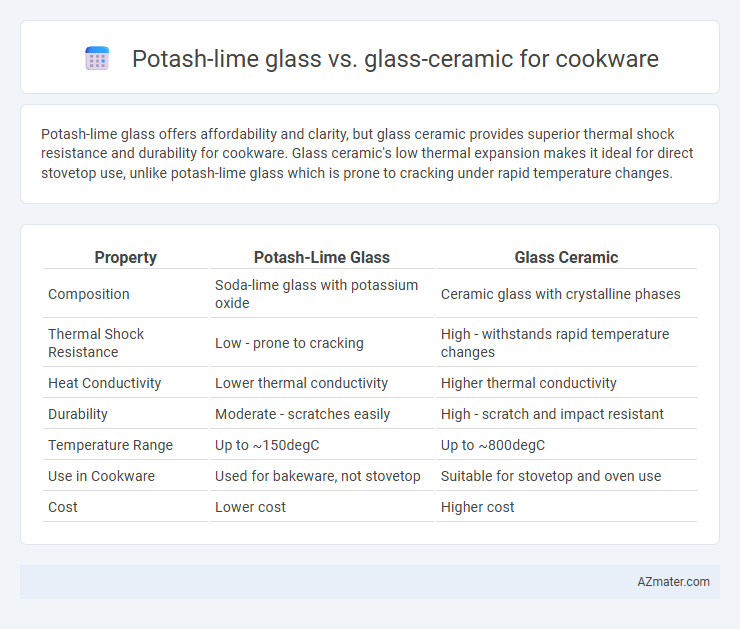Potash-lime glass offers affordability and clarity, but glass ceramic provides superior thermal shock resistance and durability for cookware. Glass ceramic's low thermal expansion makes it ideal for direct stovetop use, unlike potash-lime glass which is prone to cracking under rapid temperature changes.
Table of Comparison
| Property | Potash-Lime Glass | Glass Ceramic |
|---|---|---|
| Composition | Soda-lime glass with potassium oxide | Ceramic glass with crystalline phases |
| Thermal Shock Resistance | Low - prone to cracking | High - withstands rapid temperature changes |
| Heat Conductivity | Lower thermal conductivity | Higher thermal conductivity |
| Durability | Moderate - scratches easily | High - scratch and impact resistant |
| Temperature Range | Up to ~150degC | Up to ~800degC |
| Use in Cookware | Used for bakeware, not stovetop | Suitable for stovetop and oven use |
| Cost | Lower cost | Higher cost |
Introduction to Potash-Lime Glass and Glass Ceramic Cookware
Potash-lime glass cookware is composed primarily of silica, potash, and lime, offering moderate thermal resistance and clarity suitable for stovetop and oven use. Glass ceramic cookware features a unique microcrystalline structure, providing exceptional thermal shock resistance and durability, making it ideal for direct heat applications and rapid temperature changes. The distinct composition differences influence their thermal performance, safety, and suitability in diverse cooking environments.
Composition and Manufacturing Processes
Potash-lime glass cookware is composed primarily of silica (SiO2), potash (K2O), and lime (CaO), which are melted together at high temperatures and then annealed to relieve internal stresses. Glass ceramic cookware incorporates crystalline phases formed through controlled devitrification of a glass base, typically silica-based with added oxides like aluminum oxide (Al2O3) and lithium oxide (Li2O), resulting in superior thermal shock resistance. Manufacturing potash-lime glass involves melting and slow cooling, whereas glass ceramic requires an additional heat treatment phase to induce crystallization, enhancing mechanical strength and thermal stability.
Thermal Resistance and Heat Tolerance
Potash-lime glass typically has a lower thermal resistance and heat tolerance compared to glass ceramic, making it more prone to thermal shock and breakage under rapid temperature changes. Glass ceramic cookware offers superior heat tolerance, withstanding temperatures up to 800degC due to its crystalline microstructure that enhances thermal stability. This makes glass ceramic ideal for high-heat cooking applications, whereas potash-lime glass is better suited for moderate heat use.
Durability and Breakage Resistance
Potash-lime glass cookware offers moderate durability but is more prone to breakage due to its lower thermal shock resistance compared to glass ceramic, which is engineered for high durability and superior breakage resistance. Glass ceramic cookware withstands rapid temperature changes without cracking, making it ideal for versatile cooking applications. Its enhanced structural integrity ensures longer-lasting performance under frequent heating and cooling cycles.
Cooking Performance and Heat Distribution
Potash-lime glass cookware offers moderate heat retention but tends to have uneven heat distribution, which can result in hot spots during cooking. Glass ceramic cookware excels in thermal shock resistance and provides more uniform heat distribution, leading to consistent cooking performance. The superior heat conduction of glass ceramic materials makes them ideal for precise temperature control in various cooking methods.
Chemical Stability and Food Safety
Potash-lime glass offers moderate chemical stability with some susceptibility to alkali leaching, potentially affecting food safety over prolonged use. Glass-ceramic cookware exhibits superior chemical stability due to its crystalline structure, resulting in minimal leaching and enhanced resistance to thermal shock. This inherent stability in glass-ceramic makes it a safer option for cookware, ensuring no harmful substances migrate into food during cooking.
Design, Aesthetics, and Transparency
Potash-lime glass offers a clear and bright transparency that enhances the visual appeal of cookware, allowing users to easily monitor food during cooking. Glass ceramic, while less transparent, provides a sleek matte or glossy finish with superior heat resistance, lending a modern and durable aesthetic to kitchenware. Design-wise, potash-lime glass enables intricate shapes and delicate patterns due to its malleability, whereas glass ceramic is favored for minimalist, robust designs that emphasize functionality and longevity.
Maintenance, Cleaning, and Longevity
Potash-lime glass cookware offers easy cleaning with smooth, non-porous surfaces resistant to stains and odors, requiring minimal maintenance to maintain clarity and shine. Glass ceramic cookware features enhanced durability and thermal shock resistance, making it less prone to cracking and allowing for longer lifespan under frequent temperature fluctuations but may require careful cleaning to avoid scratches. Both materials provide good longevity, though glass ceramic is generally favored for sustained high-heat cooking environments due to its superior heat retention and resistance to wear.
Price Comparison and Market Availability
Potash-lime glass cookware is generally more affordable, making it widely accessible in mainstream markets, while glass ceramic cookware commands a higher price due to advanced heat resistance and durability features. Market availability for potash-lime glass is extensive across budget-friendly retail outlets and online platforms, whereas glass ceramic is predominantly found in specialty kitchenware stores and premium e-commerce channels. Consumers often choose potash-lime glass for cost-efficiency, while glass ceramic attracts buyers prioritizing longevity and superior thermal performance.
Pros and Cons: Potash-Lime Glass vs Glass Ceramic Cookware
Potash-lime glass cookware offers excellent clarity and is typically more affordable, but it is less resistant to thermal shock and can crack under rapid temperature changes compared to glass ceramic cookware. Glass ceramic cookware boasts superior durability, high heat resistance, and even heat distribution, making it ideal for frequent cooking and stovetop use, though it tends to be pricier and less transparent. Users must weigh potash-lime glass's budget-friendly nature and aesthetic appeal against glass ceramic's enhanced strength and performance in demanding cooking environments.

Infographic: Potash-lime glass vs Glass ceramic for Cookware \
 azmater.com
azmater.com